- absolute respect required within the hierarchy based on age, generation, [gender], and proximity of relationship
- law code: mistreating relatives could be punished by beheading, forced labor, beating; transgression of laws by inferiors was punished more severly than maltreatment of inferiors by superiors
- emulation of material and moral value system of the upper class by middle and lower class
[family loyalty: extended to group loyalty in certain circumstances: guids and native place societies for merchants in cities; secret societie; religious societies; political factions]
- matrinomial alliances: children reinforce social status of the family
- infanticide pracitced when inheritance had been divided: - foundling hospitals established in the Song; adoption
- birth date: fate related to the day and time of birth
- gentleness, obedience
- aged seven to thirteen: schooling or tutoring in elementary education (writing, reciting poetry, music) / academies
- Southern Song: Imperial Academy (ca. 1,750 students in the 13th cent; monthly exams; spring and autumn exams; colleges devoted to sages of antiquity or deified persons), Medical School (200-300 students), National University, Military Academy
- education for girls: household centered
- capping ceremony (boys aged 20), wearing the hair in hairdoes with hairpins (girls aged 15)
 Depiction of capping
ceremony on a narrative screen
Depiction of capping
ceremony on a narrative screen- no religious union but family alliance (used as a 'political weapon'); gift exchange on occasions like betrothal and marriage; marriages all arranged according to family status and prognostication based on the strokes of the names and the birthdates of bride and groom; oftentimes also based on physiognomancy; list of property to be assigned to the son in case of marriage; divorce with mutual consent possible, marriage no non-dissolvable matter
- in Hangzhou sucessful candidates were occasionally kidnapped by wealthy families to introduce them to their daughters who have reached marriage age
- meetings between the betroathed possible during negotioations of marriage conditions
- first celebration in the marriage festivities: ceremony of cups
- later on ritual exchange of symbolic gifts and gifts of high material value
- before the wedding: groom's family sends the'three golds' (bracelet, small chain, and pendant)
- marriage eve: exhibition of dowry
- marriage day: bride leaves her parents' house and is brought to her new home
- reasons for dissolving a marriage: lack of filial piety towards the in-laws; sterility; jealousy (because the -wealthy- husband had the possibility to have concubines in addition to his first 'legal' wife); illnesses preventing participation in the rites of the ancestral cult; chattering; misappropriation of the in-laws' property
- reasons that prevented a women to be divorced: the wife's parents were both deceased; the wife had obeyed a mourning period for her husband's father or mother; the husband had been poor at the time of the marriage but became wealthy during the period of marriage
- marriage virtues: modesty, chastity, conjugal fidelity, caring for the in-laws
- while some well-to-do women enjoyed a rather leisurely life, many women worked hard, - either in the household or in their family business- to support the family in coming up with the required amounts of taxes.
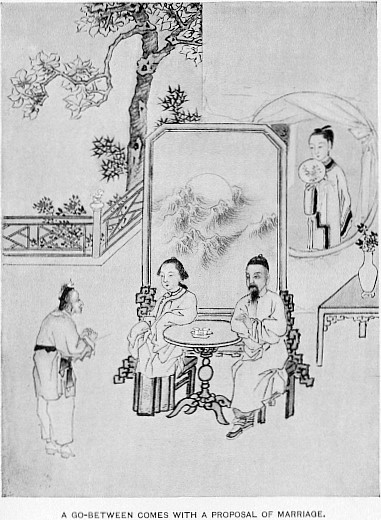
 The couple asks
for the parents' blessing
The couple asks
for the parents' blessing Dowry closet
Dowry closet- human body: 'reproduction of the cosmos'; health = harmonious bodily functions due to uninhibited circulation of 'qi' = life energy/ breath; corresponding to the sytem of harmony projected into nature, the cosmos, similar to the way it was projected into statecraft;
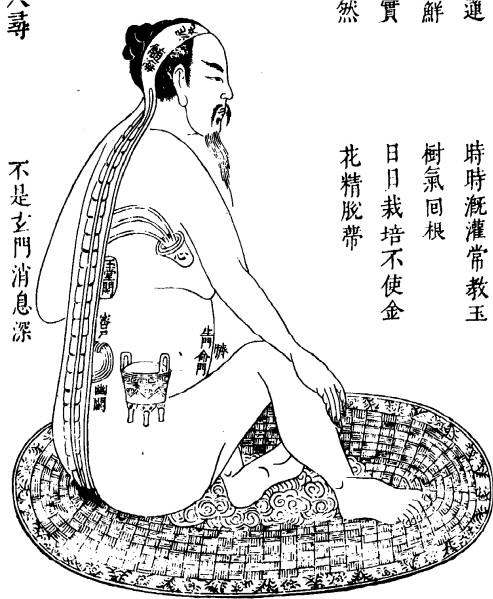
Chart showing flow of blood and 'qi'-energy
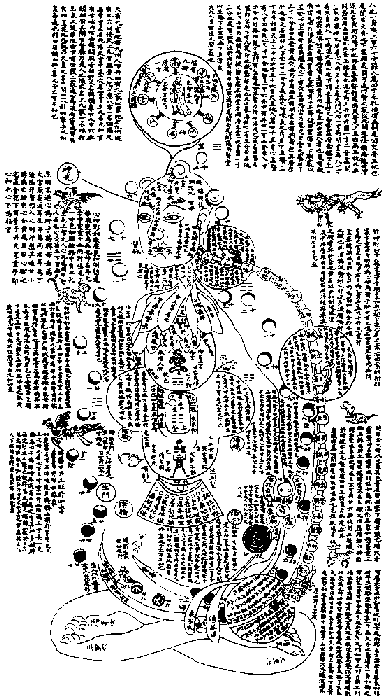
Description of 'bodily cosmos'
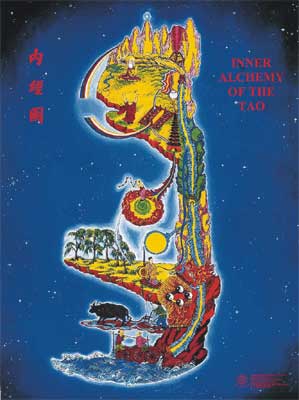 Modern interpretation
of another chart of 'inner alchemy' in which the body is conceived as a cosmic
system
Modern interpretation
of another chart of 'inner alchemy' in which the body is conceived as a cosmic
system - five element theory: correspondence of five elements, better five alternating phases of domination of the elements water, fire, wood, metal, and earth
- origins of illness: unbalance between the potency of the elements, excess of one or more of the seven sentiments (joy, anger, sadness, fear, love, hate, desire)
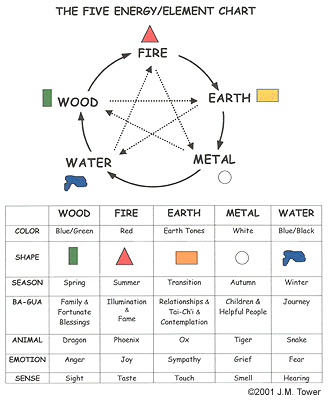
- methods for curing illnesses: acupuncture, acupressure ('massage'), moxibustion (cauterizations with artemisia etc.), 789 prescription drugs made from plants, minerals (jade, gold, mercury), and animal products (rhino horn, snake skin, stag horn), potions, elementary surgery (fractures; brain surgery by opening the skull)
- most important methods of treatment: pule feeling, acupuncture, curing ulcers, dressing wounds; rheumatism, paralyses, ophthalmology, obstetrics, dentistry, laryngology; exorcism with charms and amuletts
 Chart of acupuncture
points
Chart of acupuncture
points
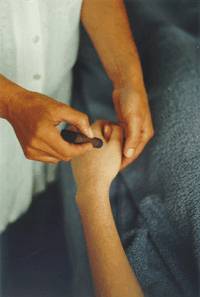
Applied moxibustion

- forensic medicine: death certificate mentions all parts of the body affected by different types of injury leading to death
- relatives had to wear coarse clothing, express their mourning by weeping and wailing (to communicate to the community AND to the soul of the deceased that they missed him/her), perform rituals in accordance with the prescribed procedures to demonstrate that the deceased was transformed into an ancestor with his/her own power over the living family members
- burials were costly because nobody wanted to appear greedy: the coffin had to be of durable wood (a filial son would give a decent coffin to his father at his 60th birthday; a very filial son would sleep in the coffin while his parent was still alive to prove that it is comfortable); the plot of land for the grave had to be examined by a specialist in geomancy;
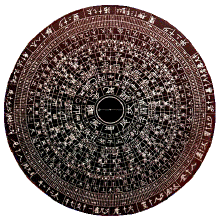 Compass of a geomancer
Compass of a geomancer- interment was the favorite mode of burial; cremation became popular under the influence of Buddhism; it was less expensive and required less space but was officially forbidden because it was not considered filial; cremation was permitted in case the deceased had to be transported over long distances (soldiers; low ranking officials/ officials in banishment who were supposed to be buried in their hometown; Buddhist monks; foreigners)
- the tombs were visited on prescribed days when the tombs were swpt and offerings were made to the sould of the deceased
 Song funerary
jar
Song funerary
jar 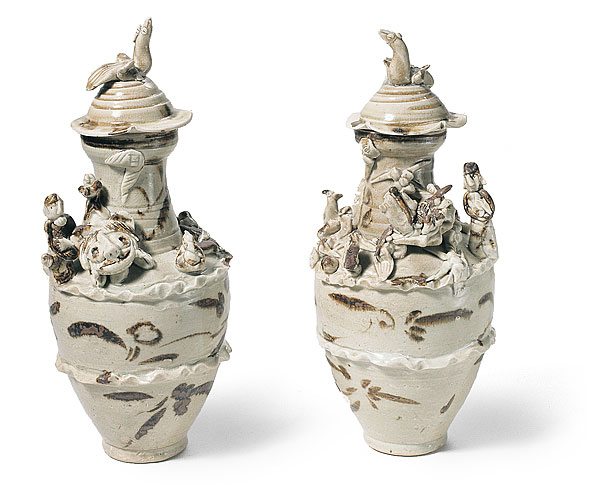
Funerary urns with Daoist symbolism
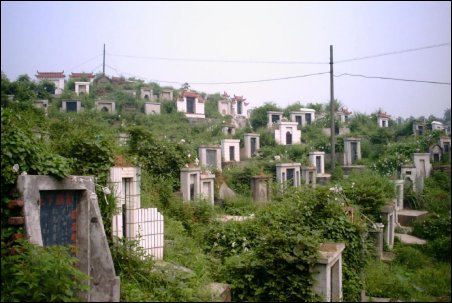 Modern
graveyard
Modern
graveyard 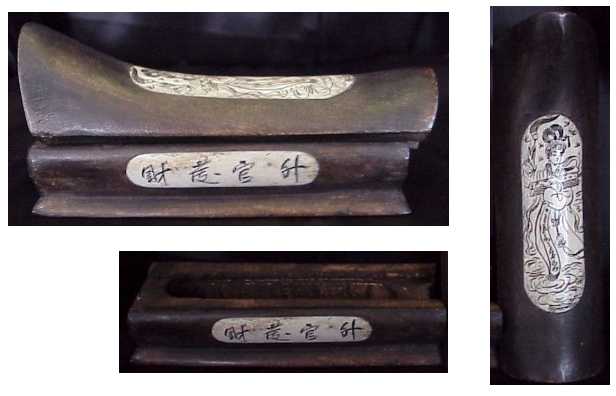
Miniature coffin
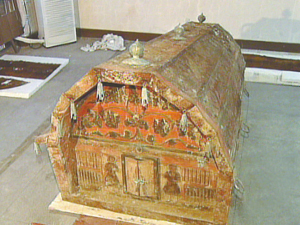 1,000
year old coffin from Inner Mongolia
1,000
year old coffin from Inner Mongolia